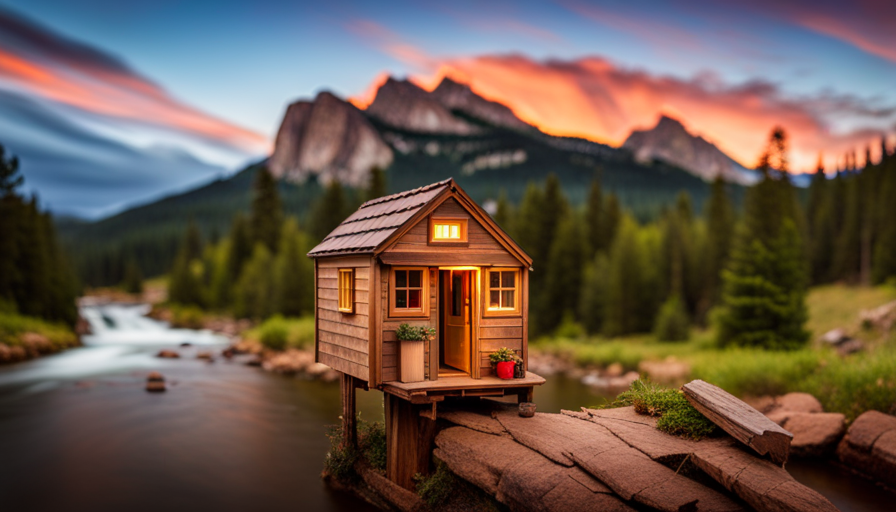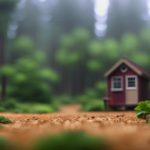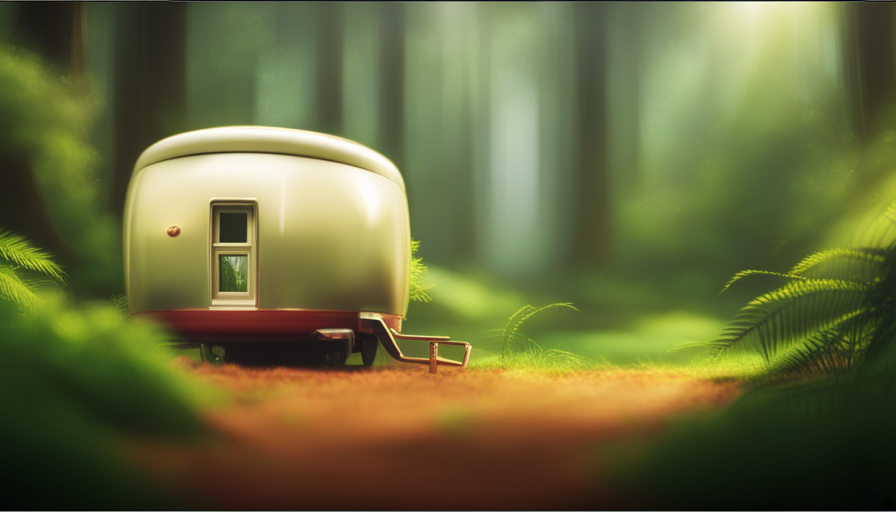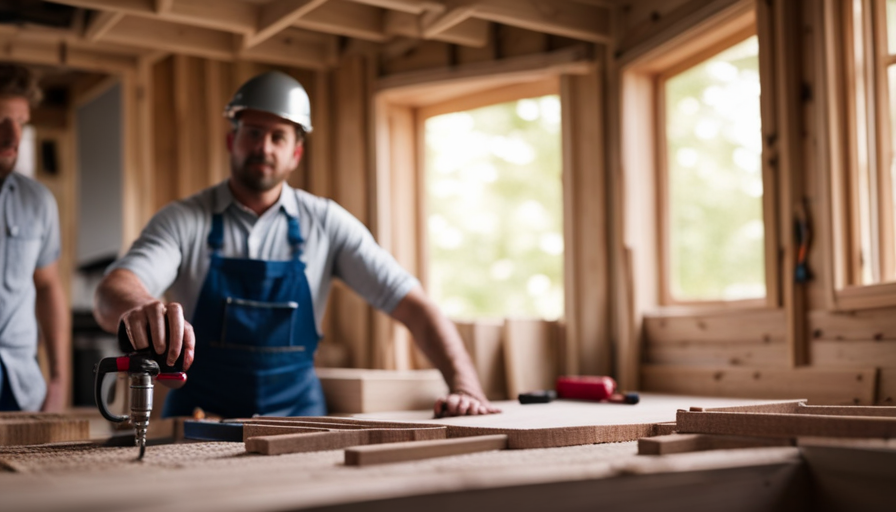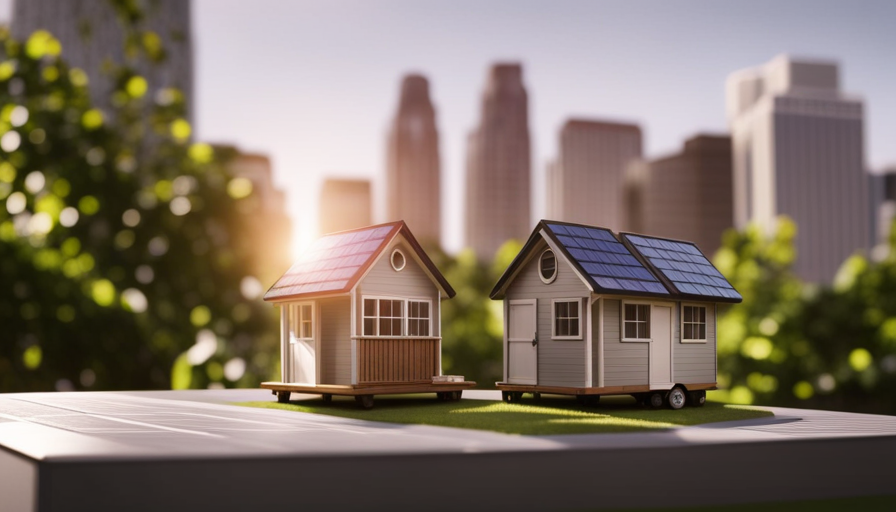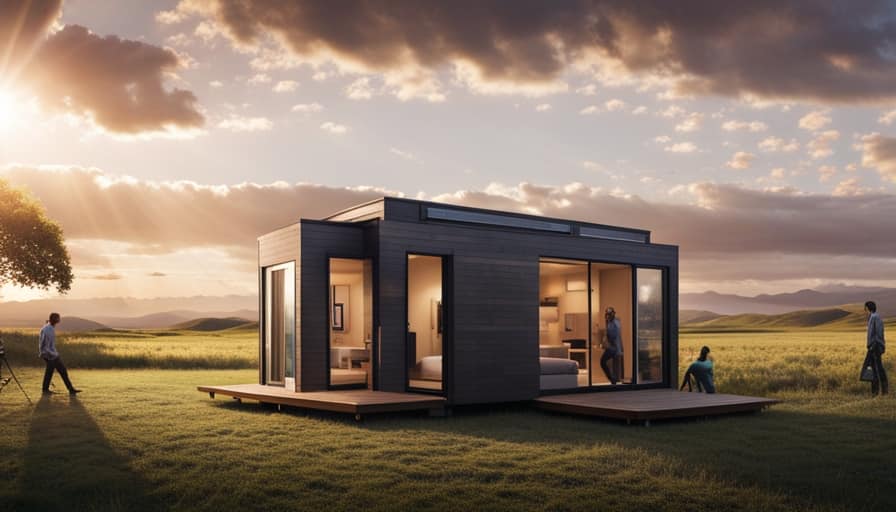Picture a charming, little house nestled among the breathtaking scenery of Boulder, Colorado. The compact size and unique design of the home are perfect for individuals seeking a more minimalist and environmentally-friendly lifestyle. But the question remains – where can you position this tiny abode in Boulder? Fear not, as I have undertaken thorough research and compiled a comprehensive guide to help you find the perfect spot for your small home.
From zoning laws and regulations to private land rentals and RV parks, I’ve got you covered. Looking for a tight-knit community of like-minded individuals? Boulder has that too. Or perhaps you prefer the coziness of parking on a friend or family member’s property. Whatever your preference, Boulder offers a range of options to accommodate your tiny house dreams.
So, let’s dive in and explore the many possibilities that await you in this vibrant and progressive city.
Key Takeaways
- Zoning laws and regulations in Boulder dictate where tiny houses can be placed.
- It is important to research and comply with building code requirements for tiny houses in Boulder.
- Parking considerations for tiny houses in Boulder include permits, safety regulations, and the option to park on private land.
- Co-living options and communities exist in Boulder for tiny house dwellers, offering shared resources and communal living spaces.
Zoning Laws and Regulations in Boulder
If you’re thinking about parking your tiny house in Boulder, you should be aware of the zoning laws and regulations that govern where you can legally place your home. Boulder has specific zoning updates and building code compliance requirements for tiny houses, so it’s crucial to familiarize yourself with these rules before making any decisions.
In Boulder, the zoning laws dictate where you can park your tiny house. The city has specific zones designated for different types of dwellings, including tiny houses. It’s essential to ensure that the area you choose is zoned appropriately for your tiny house.
Additionally, you need to comply with building code regulations to ensure the safety and structural integrity of your home.
To determine the zoning restrictions for your tiny house, you can consult the Boulder County Land Use Department or visit their website for up-to-date information. They provide detailed guidelines on zoning regulations and building code compliance.
Understanding the zoning laws and building code compliance requirements will help you navigate the process of legally parking your tiny house in Boulder. Once you have a good grasp of these regulations, you can explore the various tiny house communities in Boulder without any hassle.
Tiny House Communities in Boulder
Don’t worry about finding a place to settle down with your tiny home; there are thriving communities in Boulder that embrace the unique lifestyle. When it comes to tiny house building regulations, Boulder has specific requirements that you need to meet. These regulations include limitations on the size of the structure, as well as requirements for utilities such as water, electricity, and sewage. It’s essential to familiarize yourself with these regulations to ensure your tiny house meets all the necessary criteria.
Additionally, if you’re concerned about financing your tiny home, there are options available in Boulder. Some financial institutions offer loans specifically for tiny house construction or purchase. These loans typically have different terms and requirements than traditional home loans, so it’s crucial to research and compare your options to find the best fit for your financial situation.
Transitioning into the subsequent section about private land rentals for tiny houses, there are also opportunities in Boulder to rent private land for your tiny home. This can be a great option if you’re not ready to commit to purchasing land or joining a tiny house community. Renting private land allows you the flexibility to choose your location within Boulder while still enjoying the benefits of living in a tiny house community.
Private Land Rentals for Tiny Houses
Consider exploring the option of renting private land for your compact dwelling, allowing you the freedom to choose your ideal location without the commitment of purchasing property or joining a community. In Boulder, there are private landowners who’re open to renting out their land to tiny house owners. This can be a great alternative for those who want to live in Boulder but don’t want to be tied down to a specific location or community.
When it comes to private land rentals for tiny houses in Boulder, availability can vary. It’s important to do your research and reach out to landowners to see if they have any available spaces. Some landowners may have specific requirements or restrictions, so be sure to ask about any regulations or limitations before committing to a rental.
Rental costs for private land vary depending on factors such as location and amenities. The closer you are to the city center or popular attractions, the higher the rental cost may be. Additionally, if the land comes with utilities or hookups, the price may also be higher. It’s important to factor in these costs when considering renting private land for your tiny house.
Moving on to the next section about RV parks and campgrounds in Boulder, there are also options available for those who prefer a more communal living experience.
RV Parks and Campgrounds in Boulder
When it comes to staying in an RV park in Boulder, there are many perks that make it a great option. Firstly, the convenience of having amenities and facilities readily available is unbeatable. From electrical hookups to water and sewage services, you’ll have everything you need for a comfortable stay.
Additionally, most RV parks offer additional amenities like laundry facilities, Wi-Fi access, and recreational activities, making it a practical choice for those looking for a hassle-free camping experience.
Perks of Staying in an RV Park
You’ll absolutely love the convenience and amenities of staying in an RV park, where you can enjoy a sense of community and access to recreational facilities! In an RV park, you’ll have the opportunity to connect with fellow travelers and enjoy shared amenities such as laundry facilities, showers, and a communal kitchen. The sense of community in an RV park is unparalleled, with friendly neighbors always willing to lend a helping hand or share travel tips. The table below provides a visual representation of the various amenities and facilities available in an RV park:
| Amenities | Facilities |
|---|---|
| Laundry | Showers |
| Communal Kitchen | Picnic Areas |
| Wi-Fi | Playground |
With these fantastic amenities, you can make the most of your stay in Boulder, Colorado. Next, let’s explore the wide range of amenities and facilities available for your enjoyment.
Amenities and Facilities Available
Staying in an RV park has its perks, but what really sets it apart are the shared amenities and community facilities available to residents. These amenities vary depending on the park, but they often include things like laundry facilities, showers, and restrooms.
Some parks even offer additional perks like swimming pools, fitness centers, and recreational areas. Having access to these shared amenities can make living in a tiny house or RV much more convenient and enjoyable. It’s nice to be able to do your laundry or take a hot shower without having to worry about the limited space in your own tiny home.
Plus, the community facilities provide opportunities to socialize and connect with other like-minded individuals. And speaking of connections, let’s now explore the next section about co-living spaces for tiny house dwellers.
Co-Living Spaces for Tiny House Dwellers
When it comes to living in a tiny house, one of the biggest benefits is being part of a community and having access to shared resources. Co-living spaces are a great option for tiny house dwellers, as they offer a sense of community and the opportunity to share resources like kitchen facilities, laundry rooms, and communal spaces.
Finding compatible co-living partners is essential, as it ensures a harmonious living arrangement and can lead to lasting friendships.
Shared Resources and Community Living
In a community living in Boulder, Colorado, you can easily find shared resources for your tiny house. Living sustainably and minimizing our ecological footprint is a shared goal among tiny house dwellers, and this community is no exception.
When it comes to shared resources, you can find communal gardens where you can grow your own organic vegetables, reducing the need for store-bought produce. Additionally, there are shared tool libraries where you can borrow tools for your DIY projects, saving money and space in your tiny house. Some communities even have shared laundry facilities, reducing the need for individual machines in each tiny house.
These shared resources not only promote sustainable living but also foster a sense of community and cooperation. Moving forward, let’s explore how to find compatible co-living partners who share your values and vision for tiny house living.
Finding Compatible Co-Living Partners
Finding compatible co-living partners is essential for a successful and enjoyable shared living experience. Statistics show that 72% of tiny house dwellers report a higher level of satisfaction when living with like-minded individuals who share their values and vision for sustainable living.
When it comes to finding co-living partners, it’s important to be proactive and thorough in your search. You can start by joining local tiny house communities, attending meet-ups, and using online platforms specifically designed for co-living arrangements. Once you find potential partners, take the time to get to know them and ensure that your lifestyles and expectations align.
It’s also crucial to establish legal agreements that outline responsibilities, financial contributions, and dispute resolution processes. These agreements can help maintain harmony and prevent misunderstandings in the future.
With compatible co-living partners and clear legal agreements in place, you can create a supportive and fulfilling community living experience.
Now, let’s move on to the next section about parking considerations and safety measures.
Parking Considerations and Safety Measures
One important aspect to keep in mind when considering where to park a tiny house in Boulder, Colorado is the need to prioritize parking considerations and take necessary safety measures.
Boulder has specific parking regulations and safety requirements that must be followed to ensure a smooth and hassle-free experience.
Firstly, it’s crucial to check if you need any parking permits to park your tiny house in Boulder. Contact the local authorities or visit their website to understand the requirements and obtain the necessary permits. This will help you avoid any potential fines or legal issues.
Additionally, familiarize yourself with the safety regulations for parking a tiny house in Boulder. Ensure that your tiny house meets the necessary safety standards, such as proper fire extinguishers, smoke detectors, and secure electrical connections. It’s also important to have a clear and safe path to exit the tiny house in case of emergencies.
When parking on a friend’s or family’s property, make sure to communicate and collaborate with them regarding any parking restrictions or regulations that may apply. By working together, you can find a suitable location for your tiny house that meets all the necessary requirements.
Parking permits and safety regulations are essential considerations when parking a tiny house in Boulder, Colorado. By following these guidelines, you can ensure a safe and legal parking arrangement for your tiny house in Boulder, Colorado.
Parking on Friend’s or Family’s Property
When considering parking my tiny house on a friend’s or family’s property, there are a few key points to consider.
First and foremost, it’s crucial to establish a legal agreement between both parties to ensure that all expectations and responsibilities are clearly outlined.
Additionally, it’s important to assess the compatibility of the tiny house with the property in terms of size, utilities, and zoning regulations.
Lastly, accessibility should be taken into account, including factors such as proximity to amenities, parking space availability, and any potential restrictions or limitations.
By addressing these points, I can ensure a smooth and successful arrangement for parking my tiny house on a friend’s or family’s property.
Establishing a Legal Agreement
Although it’s crucial to establish a legal agreement, it’s important to note that parking a tiny house in Boulder, Colorado can be challenging. To navigate the legal requirements and ensure a smooth parking experience, here are four key steps to consider:
-
Consult local zoning regulations: Understanding the specific rules and restrictions in Boulder regarding tiny house parking is essential. Check with the city’s zoning department or consult an attorney familiar with local laws.
-
Obtain necessary permits: Depending on the location and duration of the parking, you may need to obtain permits or licenses. Research the required documentation and submit the applications in a timely manner to avoid any legal complications.
-
Draft a comprehensive agreement: Establish a legal contract between you and the property owner, outlining the terms and conditions of the parking arrangement. Include details such as rent, duration, utilities, and maintenance responsibilities.
-
Seek legal advice: It’s always wise to consult with a lawyer experienced in real estate and zoning laws. They can provide guidance, review the agreement, and ensure compliance with all legal requirements.
By taking these steps, you can establish a solid legal foundation for parking your tiny house in Boulder. Ensuring compatibility and accessibility with the property will be the next essential aspect to consider.
Ensuring Compatibility and Accessibility
After establishing a legal agreement for parking a tiny house in Boulder, Colorado, it’s crucial to ensure compatibility and accessibility.
When it comes to co-living, it’s important to find a parking spot that’s compatible with your lifestyle and needs. Consider factors such as noise levels, privacy, and shared amenities.
Additionally, parking safety measures should be taken into account to protect your tiny house and belongings. Look for a location with adequate lighting, security cameras, and a secure entrance. It’s also important to inquire about any parking regulations or restrictions in the area to avoid any unwanted surprises.
By considering these factors, you can find a parking spot that suits your needs and provides a safe and compatible environment for your tiny house.
In the following section, we’ll explore tiny house-friendly neighborhoods in Boulder where you can find suitable parking options.
Tiny House-Friendly Neighborhoods in Boulder
When looking for tiny house-friendly neighborhoods in Boulder, it’s important to research the regulations of each neighborhood. This can be done by contacting the local community associations or checking their websites for any specific guidelines or restrictions. Engaging with the local community associations is also crucial as they can provide valuable information and support for those looking to live in a tiny house.
Researching Neighborhood Regulations
While researching neighborhood regulations for parking a tiny house in Boulder, Colorado, it becomes evident that understanding the local zoning codes is crucial to ensure compliance and avoid potential legal issues. To assist in this process, I have created a table below outlining the basic zoning codes that may affect parking a tiny house in Boulder:
| Zoning Code | Tiny House Parking Regulations |
|---|---|
| Residential | Allowed with certain restrictions, such as setback requirements and size limitations. |
| Commercial | Generally not permitted, unless specifically zoned for mixed-use or residential purposes. |
| Industrial | May have more flexibility, but still subject to size and setback limitations. |
| Recreational | Limited options, as these areas are typically reserved for recreational activities rather than permanent dwellings. |
| Agricultural | Potential for parking, but may have additional requirements, such as being part of a farm or agricultural operation. |
Understanding these zoning codes will help determine which neighborhoods are more suitable for parking a tiny house. In the next section, I will explore the importance of engaging with local community associations to gather further information on specific neighborhood regulations.
Engaging with Local Community Associations
To fully immerse yourself in the charm and character of a neighborhood, it’s essential to connect with local community associations and discover valuable insights on regulations and guidelines.
Engaging with local community associations is a great way to navigate city permits and restrictions when it comes to parking a tiny house in Boulder, Colorado. These associations have a wealth of knowledge and can provide you with information on zoning laws, parking regulations, and any specific guidelines related to alternative housing options. They can also connect you with other tiny house owners in the area who’ve successfully navigated the process.
By actively engaging with these associations, you can ensure that you are well-informed and prepared to make the right decisions for your tiny house.
Moving forward, let’s explore alternative housing options in Boulder.
Alternative Housing Options in Boulder
In Boulder, there are alternative housing options that can be considered if you’re looking for something different.
Converted sheds and garages are a popular choice, providing a compact yet functional living space. These structures can be transformed into cozy homes, with the potential to include basic amenities such as a bathroom and kitchenette.
Additionally, accessory dwelling units (ADUs) offer another option for alternative housing. ADUs are separate living spaces that can be built on the same property as an existing home, providing a separate living space for family members or as a rental unit. They can be designed to be self-sufficient with their own utilities and have the potential to add value to the property.
Converted Sheds and Garages
When exploring parking options for your tiny house in Boulder, Colorado, consider the unique charm and potential of converted sheds and garages. These alternative housing options can provide a convenient and affordable solution for your parking needs.
-
Converted Sheds: These small structures offer a cozy and compact living space for your tiny house. With some modifications, such as insulation and plumbing, they can provide all the necessary amenities. Additionally, converted sheds often have their own entrances and parking spaces, ensuring privacy and convenience.
-
Garages: If you’re looking for a slightly larger space, consider renting a garage for your tiny house. Garages can provide ample space for parking and storage, allowing you to maximize the functionality of your tiny house.
-
Backyard Parking: Many homeowners in Boulder are open to renting out their backyard space for tiny house parking. This arrangement can offer a peaceful and private location for your tiny house, while also allowing you to build a sense of community with your landlord.
When considering converted sheds and garages for your tiny house parking needs, it’s important to carefully review rental agreements and ensure that the space meets your specific requirements.
Moving on to the next topic, let’s explore the benefits of accessory dwelling units (ADUs) for parking your tiny house in Boulder.
Accessory Dwelling Units (ADUs)
After exploring the possibility of converted sheds and garages, I discovered another attractive option for parking a tiny house in Boulder, Colorado: Accessory Dwelling Units (ADUs).
ADUs are separate living units that are built on the same property as a single-family home. These units can be either attached or detached from the main house and are designed to be fully functional living spaces. The great thing about ADUs is that they’re becoming increasingly popular in Boulder, with many neighborhoods embracing the concept of tiny house living.
This means that there are more opportunities to find a suitable parking spot for your tiny house in one of these ADU-friendly neighborhoods.
In the next section, I’ll provide you with some valuable resources and websites that can help you in your search for the perfect spot for your tiny house in Boulder.
Resources and Websites for Tiny House Parking in Boulder
To find parking for your tiny house in Boulder, check out these websites and resources that provide information on available spaces and regulations. Did you know that according to a recent survey, the demand for tiny house parking in Boulder has increased by 40% in the last year?
Here are four resources and websites that can help you navigate the process of finding parking for your tiny house:
-
Boulder Housing Network: This website offers information on cooperative living opportunities in Boulder, where you can find communities that allow tiny houses. They provide resources on finding affordable housing options and cooperative living arrangements.
-
City of Boulder Planning and Development Services: The city’s website provides detailed information on tiny house parking regulations. You can find the zoning codes and requirements for parking your tiny house legally within the city limits. It’s important to familiarize yourself with these regulations to avoid any legal issues.
-
Tiny House Community: This online platform connects tiny house owners with available parking spaces in Boulder. You can search for parking options, connect with other tiny house owners, and even find communities that welcome tiny houses.
-
Boulder County Tiny House Enthusiasts: This local group on social media is a great resource for connecting with other tiny house owners in Boulder. They often share information about available parking spaces and can provide valuable insights and advice on navigating the parking process.
By utilizing these resources and websites, you can find the perfect parking spot for your tiny house in Boulder while staying compliant with the regulations.
Frequently Asked Questions
Can I legally park my tiny house on any street in Boulder?
No, it is not legal to park a tiny house on any street in Boulder. There are specific legal requirements and parking regulations that must be followed. It is important to research and abide by these guidelines to avoid any legal issues.
Are there any age restrictions for staying in RV parks and campgrounds in Boulder?
There are no specific age restrictions for staying in RV parks and campgrounds in Boulder. However, it is important to check with each individual park or campground for their specific rules and regulations. When looking for a place to park a tiny house in Boulder, consider private properties, RV parks, or campgrounds that allow tiny house parking.
What are some safety measures that should be taken when parking a tiny house in Boulder?
When parking a tiny house in Boulder, safety precautions are crucial. It’s important to comply with parking regulations, secure the house properly, install smoke detectors, and have a fire extinguisher handy. Safety first, always!
Are there any restrictions on parking a tiny house on private land in Boulder?
Tiny house parking regulations in Boulder, Colorado can vary depending on the zoning and local ordinances. It’s important to research and understand these regulations before parking your tiny house on private land. Additionally, you can explore options like RV parks, tiny house communities, or renting a space from a homeowner.
Are there any financial assistance programs available for parking a tiny house in Boulder?
Financial assistance programs are not available specifically for parking a tiny house in Boulder. However, there may be general housing assistance programs available that could potentially be used for this purpose. It is important to check local regulations regarding parking.
Conclusion
After exploring the various options for parking a tiny house in Boulder, it’s clear that there are plenty of opportunities available.
From private land rentals and RV parks to co-living spaces and friendly neighborhoods, Boulder offers a range of choices for tiny house dwellers.
Whether you’re looking for a sense of community or prefer the privacy of your own land, there’s something for everyone.
So pack your bags and get ready to embark on your tiny house adventure in beautiful Boulder, where the possibilities are endless and the scenery is breathtaking.
Happy parking!
Hi, I’m Emma. I’m the Editor in Chief of Tiny House 43, a blog all about tiny houses. While tree houses are often associated with childhood, they can be the perfect adult retreat. They offer a cozy space to relax and unwind, surrounded by nature. And since they’re typically built on stilts or raised platforms, they offer stunning views that traditional homes simply can’t match. If you’re looking for a unique and romantic getaway, a tree house tiny house might just be the perfect option.
